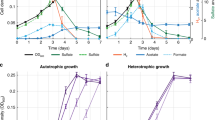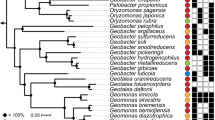Abstract
Two years ago we began to study whether Thiobacillus thioparus and T. denitrificans could break down thiocyanate oxidatively in the same way as T. thiocyanoxidans; it was immediately apparent that the former did, but since initial results suggested that the first and last of these organisms might nevertheless be separate species we decided not to publish our results at that time. All strains of T. denitrificans received were contaminated and since it has been our practice to work from single-cell culture we abandoned temporarily the study of T. denitrificans.
This is a preview of subscription content, access via your institution
Access options
Subscribe to this journal
Receive 51 print issues and online access
$199.00 per year
only $3.90 per issue
Buy this article
- Purchase on Springer Link
- Instant access to full article PDF
Prices may be subject to local taxes which are calculated during checkout
Similar content being viewed by others

References
De Kruyff, Catharina D., van der Walt, J. P., and Schwartz, H. M., “Antonie van Leeuwenhoek”, 23 (1957).
“Autotrophic Micro-organisms” (Cambridge, 1954).
Ministry of Health, Ministry of Housing and Local Government, Reports on Public Health and Medical Subjects, No. 71 (1957).
Beijerinck, M. W., Centralbl. Bakt., 11, 593 (1904).
Author information
Authors and Affiliations
Rights and permissions
About this article
Cite this article
HAPPOLD, F., JONES, G. & PRATT, D. Utilization of Thiocyanate by Thiobacillus thioparus and T. thiocyanoxidans . Nature 182, 266–267 (1958). https://doi.org/10.1038/182266a0
Issue Date:
DOI: https://doi.org/10.1038/182266a0
This article is cited by
-
Characterization of an autotrophic bioreactor microbial consortium degrading thiocyanate
Applied Microbiology and Biotechnology (2017)
-
New insights into the genetic and metabolic diversity of thiocyanate-degrading microbial consortia
Applied Microbiology and Biotechnology (2016)
Comments
By submitting a comment you agree to abide by our Terms and Community Guidelines. If you find something abusive or that does not comply with our terms or guidelines please flag it as inappropriate.


